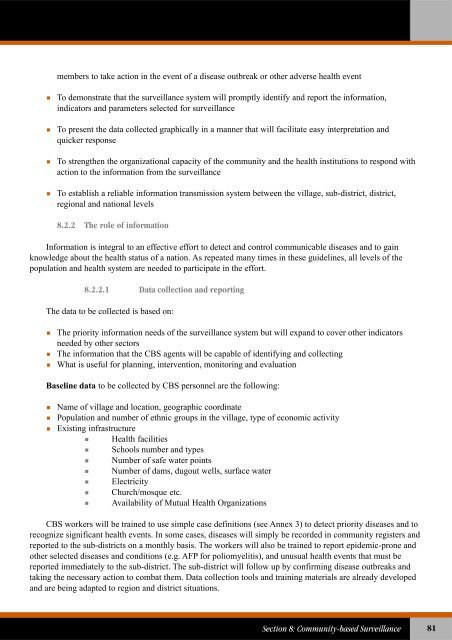Technical Guidelines for Integrated Disease Surveillance ... - PHRplus
Technical Guidelines for Integrated Disease Surveillance ... - PHRplus
Technical Guidelines for Integrated Disease Surveillance ... - PHRplus
You also want an ePaper? Increase the reach of your titles
YUMPU automatically turns print PDFs into web optimized ePapers that Google loves.
members to take action in the event of a disease outbreak or other adverse health event To demonstrate that the surveillance system will promptly identify and report the in<strong>for</strong>mation,indicators and parameters selected <strong>for</strong> surveillance To present the data collected graphically in a manner that will facilitate easy interpretation andquicker response To strengthen the organizational capacity of the community and the health institutions to respond withaction to the in<strong>for</strong>mation from the surveillance To establish a reliable in<strong>for</strong>mation transmission system between the village, sub-district, district,regional and national levels8.2.2 The role of in<strong>for</strong>mationIn<strong>for</strong>mation is integral to an effective ef<strong>for</strong>t to detect and control communicable diseases and to gainknowledge about the health status of a nation. As repeated many times in these guidelines, all levels of thepopulation and health system are needed to participate in the ef<strong>for</strong>t.8.2.2.1 Data collection and reportingThe data to be collected is based on: The priority in<strong>for</strong>mation needs of the surveillance system but will expand to cover other indicatorsneeded by other sectors The in<strong>for</strong>mation that the CBS agents will be capable of identifying and collecting What is useful <strong>for</strong> planning, intervention, monitoring and evaluationBaseline data to be collected by CBS personnel are the following: Name of village and location, geographic coordinate Population and number of ethnic groups in the village, type of economic activity Existing infrastructure Health facilities Schools number and types Number of safe water points Number of dams, dugout wells, surface water Electricity Church/mosque etc.Availability of Mutual Health OrganizationsCBS workers will be trained to use simple case definitions (see Annex 3) to detect priority diseases and torecognize significant health events. In some cases, diseases will simply be recorded in community registers andreported to the sub-districts on a monthly basis. The workers will also be trained to report epidemic-prone andother selected diseases and conditions (e.g. AFP <strong>for</strong> poliomyelitis), and unusual health events that must bereported immediately to the sub-district. The sub-district will follow up by confirming disease outbreaks andtaking the necessary action to combat them. Data collection tools and training materials are already developedand are being adapted to region and district situations.Section 8: Community-based <strong>Surveillance</strong>81















